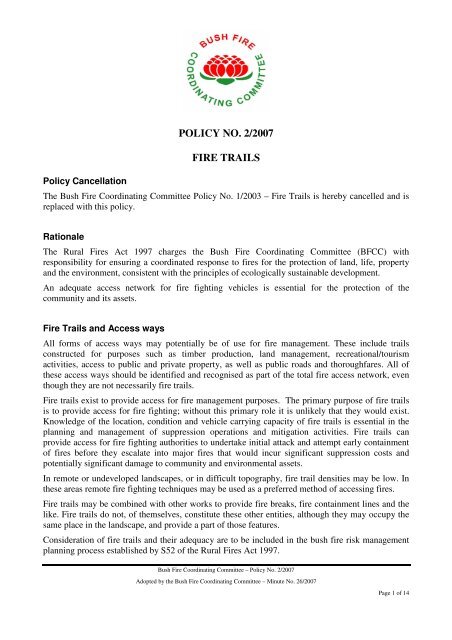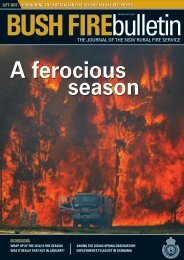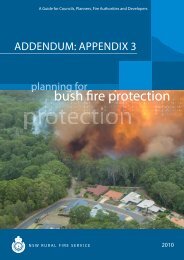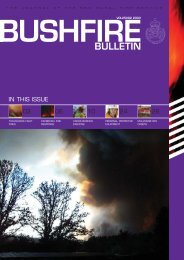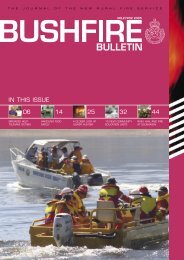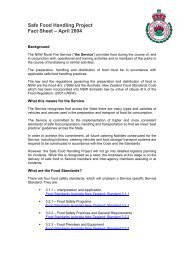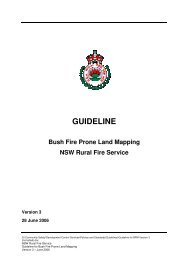POLICY NO. 2/2007 FIRE TRAILS - NSW Rural Fire Service
POLICY NO. 2/2007 FIRE TRAILS - NSW Rural Fire Service
POLICY NO. 2/2007 FIRE TRAILS - NSW Rural Fire Service
You also want an ePaper? Increase the reach of your titles
YUMPU automatically turns print PDFs into web optimized ePapers that Google loves.
Policy Cancellation<br />
<strong>POLICY</strong> <strong>NO</strong>. 2/<strong>2007</strong><br />
<strong>FIRE</strong> <strong>TRAILS</strong><br />
The Bush <strong>Fire</strong> Coordinating Committee Policy No. 1/2003 – <strong>Fire</strong> Trails is hereby cancelled and is<br />
replaced with this policy.<br />
Rationale<br />
The <strong>Rural</strong> <strong>Fire</strong>s Act 1997 charges the Bush <strong>Fire</strong> Coordinating Committee (BFCC) with<br />
responsibility for ensuring a coordinated response to fires for the protection of land, life, property<br />
and the environment, consistent with the principles of ecologically sustainable development.<br />
An adequate access network for fire fighting vehicles is essential for the protection of the<br />
community and its assets.<br />
<strong>Fire</strong> Trails and Access ways<br />
All forms of access ways may potentially be of use for fire management. These include trails<br />
constructed for purposes such as timber production, land management, recreational/tourism<br />
activities, access to public and private property, as well as public roads and thoroughfares. All of<br />
these access ways should be identified and recognised as part of the total fire access network, even<br />
though they are not necessarily fire trails.<br />
<strong>Fire</strong> trails exist to provide access for fire management purposes. The primary purpose of fire trails<br />
is to provide access for fire fighting; without this primary role it is unlikely that they would exist.<br />
Knowledge of the location, condition and vehicle carrying capacity of fire trails is essential in the<br />
planning and management of suppression operations and mitigation activities. <strong>Fire</strong> trails can<br />
provide access for fire fighting authorities to undertake initial attack and attempt early containment<br />
of fires before they escalate into major fires that would incur significant suppression costs and<br />
potentially significant damage to community and environmental assets.<br />
In remote or undeveloped landscapes, or in difficult topography, fire trail densities may be low. In<br />
these areas remote fire fighting techniques may be used as a preferred method of accessing fires.<br />
<strong>Fire</strong> trails may be combined with other works to provide fire breaks, fire containment lines and the<br />
like. <strong>Fire</strong> trails do not, of themselves, constitute these other entities, although they may occupy the<br />
same place in the landscape, and provide a part of those features.<br />
Consideration of fire trails and their adequacy are to be included in the bush fire risk management<br />
planning process established by S52 of the <strong>Rural</strong> <strong>Fire</strong>s Act 1997.<br />
Bush <strong>Fire</strong> Coordinating Committee – Policy No. 2/<strong>2007</strong><br />
Adopted by the Bush <strong>Fire</strong> Coordinating Committee – Minute No. 26/<strong>2007</strong><br />
Page 1 of 14
Notwithstanding their value in fire suppression, fire trails may have adverse impacts on<br />
environmental, social and economic values. These impacts may include:<br />
• Illegal activities taking advantage of improved access, such as arson, dumping, trespassing,<br />
bush rock/soil and vegetation removal.<br />
• Increased public access of a legal nature such as use of trail bikes and 4WDs, which may<br />
lead to soil erosion and accelerated track degradation, noise nuisance and public safety<br />
hazards.<br />
• Degradation of native vegetation and biodiversity through edge effects and habitat<br />
fragmentation, weed and pest invasion.<br />
• Soil erosion and degradation of water quality, siltation of watercourses and storages.<br />
• Damage to cultural heritage items and places.<br />
• Cost of construction and maintenance.<br />
The BFCC’s interest in fire trails is limited to fire management purposes. It is recognised that many<br />
fire trails are used for other purposes as well.<br />
Classification of <strong>Fire</strong> Trails<br />
<strong>Fire</strong> trails need to be identified and identifiable in a consistent way so as to convey to fire<br />
management personnel the condition, purpose and accessibility of the fire trail.<br />
BFMCs must determine which access ways in their area are to be classed as ‘fire trails’. This<br />
decision is to be reached by consensus, with a view to the entire fire access network within the area,<br />
and adjoining areas where this is relevant (e.g. a main link road entering the BFMC’s area from the<br />
neighbouring BFMC area).<br />
Once the fire trails are identified, they are to be classified on the basis of strategic importance and<br />
vehicle carrying capacity, as specified below. Two sets of classifications are to be made for each<br />
fire trail: on current circumstances, and on desired future circumstances. Many trail classifications<br />
will be the same in both circumstances.<br />
Two classifications are required so that the current condition information is available for use during<br />
fire fighting operations, while the desired future condition information is essential for the BFMC<br />
and land owner/managers to make strategic decisions about ongoing management, maintenance and<br />
upgrading. The difference between existing and desired future condition may involve a<br />
classification going up (e.g. from important to essential), but may also include a classification going<br />
down (e.g. from important to dormant because another, more strategically useful trail has been<br />
upgraded taking over the main role of the first trail).<br />
Strategic Classification<br />
Essential: This is a fire trail without which fire response and suppression in an area would be<br />
severely compromised. All reasonable efforts must be made to ensure that this trail is trafficable to<br />
the agreed vehicle carrying capacity at all times. Sudden problems such as tree falls and land slips<br />
should be rectified as soon as identified. This trail should be checked on occasions throughout each<br />
year, and particularly before the commencement of the local bush fire season.<br />
Bush <strong>Fire</strong> Coordinating Committee – Policy No. 2/<strong>2007</strong><br />
Adopted by the Bush <strong>Fire</strong> Coordinating Committee – Minute No. 26/<strong>2007</strong><br />
Page 2 of 14
Physical barriers to vehicle access must not be deliberately installed, unless they are readily<br />
broached by fire fighters. That is, a locked gate with key access for fire fighters would be<br />
acceptable; fixed bollards, felled trees, piles of rock and the like would not be acceptable, as the<br />
obstruction cannot be removed by a fire fighting crew without additional machinery.<br />
Important: This is a fire trail that is required for fire management. If this trail was unusable due to<br />
temporary circumstances, other trails could be used to contain a fire, albeit with some loss of fire<br />
management efficiency. This trail should be trafficable to the agreed vehicle carrying capacity at all<br />
times. This trail should be checked before the commencement of the local bush fire season.<br />
Dormant: This is a track or trail that has been used at some time in the past, but where there is no<br />
requirement for it to be constantly maintained in a trafficable state.<br />
Vehicle Carrying Capacity<br />
This policy is limited to the criteria required to specify the vehicle carrying capacity of various<br />
roads, tracks and trails used for fire management purposes. This is about whether a vehicle can<br />
physically pass from A to B, not whether it will be safe to do so in certain fire conditions. The<br />
decision as to whether or not to use a trail under fire conditions must be made by the officer in<br />
charge at the time of the fire, taking into account prevailing conditions.<br />
Cat 1: This is a fire trail that can be safely traversed by a Category 1 fire fighting appliance.<br />
Cat 7: This is a fire trail that can be safely traversed by a Category 7 fire fighting appliance.<br />
Cat 9: This is a fire trail that can be safely traversed by a Category 9 fire fighting appliance.<br />
Information on how to assess vehicle carrying capacity is provided at Annex A.<br />
<strong>Fire</strong> Trail Registers<br />
Bush <strong>Fire</strong> Management Committees must regularly maintain and update a <strong>Fire</strong> Trail Register for<br />
their area of responsibility. <strong>Fire</strong> Trail Registers record information for administrative, planning and<br />
operational purposes including location, strategic value and vehicle carrying capacity. <strong>Fire</strong> trail<br />
registers are to be created and maintained in BRIMS. <strong>Fire</strong> trail register specifications are provided<br />
at Annex B. A component of the fire trail register is a map. This map is not to be available to the<br />
general public, due to the sensitivity of information it may contain, and the desire of landowners to<br />
prevent unauthorised use of the trails so identified.<br />
The BFMC must discuss and agree on an adequate fire access network for its area, across all land<br />
tenures. This network is to include all types of access, including fire trails. The network must be<br />
agreed on the basis of both existing and desired future standards.<br />
In identifying fire trails, consideration should be given to the entire fire access network. Existing<br />
tracks and trails may not be suitable for continued use and maintenance as fire trails, and<br />
consideration should be given to reconstruction or realignment to achieve safer use or avoid<br />
environmentally sensitive areas, or closure and rehabilitation of trails that are not required or which<br />
have ongoing significant adverse environmental impacts. New trails may be proposed and<br />
constructed.<br />
Land owner/managers may make recommendations to the BFMC about the information to be<br />
recorded in the fire trail register about trails on their estate. The BFMC must reach a decision as to<br />
the names and categories assigned to the trails. These decisions are to be reached by consensus.<br />
Bush <strong>Fire</strong> Coordinating Committee – Policy No. 2/<strong>2007</strong><br />
Adopted by the Bush <strong>Fire</strong> Coordinating Committee – Minute No. 26/<strong>2007</strong><br />
Page 3 of 14
BFCC Policy 1/00 Dispute Avoidance – Dispute Resolution provides guidance if difficulty is<br />
encountered in reaching agreed determinations.<br />
Map Depiction of <strong>Fire</strong> Trails<br />
There is a need to display a range of fire trail attributes on maps for a variety of purposes. Not all<br />
attributes are required for all purposes.<br />
<strong>Fire</strong> trails are to be depicted on maps in a consistent manner by all land managers/owners.<br />
Depictions are to be in accordance with Annex C.<br />
<strong>Fire</strong> Trail Signage<br />
The purpose of marking fire trails is to convey sufficient information to fire crews on the<br />
identification of the trail for fire fighting purposes. Consistent standards for signposting of fire trails<br />
across <strong>NSW</strong> are provided at Annex D. The purpose of signs on fire trails is to provide information<br />
to fire fighters to confirm the location of trails and other features. Signs for public education or<br />
awareness purposes are outside the scope of this policy.<br />
A sign is merely an indicator – it cannot convey all available information about a trail. The fire trail<br />
sign is a link to another source of information about the trail: a map and/or register of trail<br />
information, so that additional information can be sourced as required.<br />
<strong>Fire</strong> fighting authorities’ need for signs is to ensure that fire fighting crews can check that they are<br />
in the location they intended to be, specifically during fire fighting operations. That is, they need to<br />
be able to check that they are in the place they were sent to, or are able to describe their location to<br />
others.<br />
<strong>Fire</strong> trail signs must be easily usable by fire fighters, be effective for their purpose, reliable, and it<br />
must be realistic for land owners/mangers to install them. <strong>Fire</strong> trail signage needs to be undertaken<br />
in the most efficient and effective means possible, recognising the need to minimise the cost of<br />
implementation.<br />
Signs may be prone to high levels of vandalism, theft, and degradation and trail condition can<br />
change considerably under extreme weather conditions or through inappropriate use. Therefore<br />
signs are only accurate at the time they were erected. <strong>Fire</strong> trail signage in no way diminishes the<br />
responsibility of a fire fighter to inspect the condition of a fire trail prior to use, to drive within their<br />
capacity and be able to read and understand a map.<br />
Land management agencies and owners will determine maintenance and inspection requirements<br />
for fire trail signs based on resources available and assessed risk.<br />
Permanent Signs<br />
Some permanent signs in an area are desirable. It is the prerogative of the local BFMC to decide<br />
which signs are required for fire purposes, and for agencies to pursue funding for installation of<br />
these. The decision as to what signage should be erected for other purposes is rightly the province<br />
of the land owners/managers involved, and is not subject to the direction of the BFMC. It is also<br />
reasonable for a land owner/manager to install fire trail signs for its convenience over and above<br />
what the BFMC considers essential, if it wishes to do so.<br />
In deciding whether to install permanent signs, the BFMC should consider:<br />
Bush <strong>Fire</strong> Coordinating Committee – Policy No. 2/<strong>2007</strong><br />
Adopted by the Bush <strong>Fire</strong> Coordinating Committee – Minute No. 26/<strong>2007</strong><br />
Page 4 of 14
• Strategic importance of the trail<br />
• Bush fire risk and fire history of the locality serviced by the trail<br />
• Needs and its benefit in aiding fire suppression operations<br />
Temporary Signs<br />
Temporary signs may be installed by land managers and fire fighting authorities as required. Signs<br />
are to be in accordance with Annex D.<br />
Construction and Maintenance of <strong>Fire</strong> Trails<br />
<strong>Fire</strong> trails should be constructed and maintained to facilitate bush fire management activities while<br />
ameliorating adverse impacts.<br />
The BFMC should work together to ensure that all fire trails are inspected annually. This should be<br />
a cooperative effort.<br />
Best practice guidelines for construction and maintenance are attached at Annex E.<br />
Review of <strong>Fire</strong> Trail Policy<br />
The BFCC has agreed that this policy be reviewed by 1 August 2008.<br />
Chairperson<br />
1 August <strong>2007</strong><br />
Annexures:<br />
A. Assessment of Vehicle of Carrying Capacity.<br />
B. <strong>Fire</strong> Trail Registers.<br />
C. Map Depictions Standards for <strong>Fire</strong> Trails.<br />
D. <strong>Fire</strong> Trail Marking and Signage.<br />
E. Best Practice Guidelines for <strong>Fire</strong> Trail Construction and Maintenance.<br />
Bush <strong>Fire</strong> Coordinating Committee – Policy No. 2/<strong>2007</strong><br />
Adopted by the Bush <strong>Fire</strong> Coordinating Committee – Minute No. 26/<strong>2007</strong><br />
Page 5 of 14
Annex A to<br />
BFCC Policy No. 2/<strong>2007</strong><br />
Assessment of Vehicle Carrying Capacity<br />
Trails are to be assessed on their capacity to accommodate vehicle sizes as specified below.<br />
Assessment can be made by measurement of specified dimensions along the trail, or can be tested in<br />
the field by driving the vehicle along the trail. In this case the vehicle is to be driven by an<br />
appropriately licensed and competent person. It must be possible for the vehicle to be driven safely<br />
along the trail without damage to the vehicle due to overhanging vegetation, built structures, rough<br />
trail surface or other physical impediments.<br />
Category 1:<br />
This is a fire trail that can be safely traversed by a Category 1 fire fighting appliance. A Category 1<br />
fire fighting appliance generally has the following specifications:<br />
Length<br />
Width<br />
Height<br />
Ground clearance<br />
Approach angle 35º<br />
Departure angle 30º<br />
Distance between axles for clearance of drains<br />
Turning circle – wall to wall<br />
Weight<br />
8500 mm<br />
2800 mm (including 400 mm for mirrors)<br />
4000 mm (including 600 mm for aerials)<br />
310 mm<br />
4700 mm<br />
22 m diameter<br />
15000 kg<br />
Category 7:<br />
This is a fire trail that can be safely traversed by a Category 7 fire fighting appliance. A Category 7<br />
fire fighting appliance generally has the following specifications:<br />
Length<br />
Width<br />
Height<br />
Ground clearance<br />
Approach angle 35º<br />
Departure angle 30º<br />
Distance between axles for clearance of drains<br />
Turning circle – wall to wall<br />
Weight<br />
6500 mm<br />
2600 mm (including 400 mm for mirrors)<br />
3200 mm (including 500 mm for aerials)<br />
215 mm<br />
3400 mm<br />
17 m diameter<br />
7000 kg<br />
Bush <strong>Fire</strong> Coordinating Committee – Policy No. 2/<strong>2007</strong><br />
Adopted by the Bush <strong>Fire</strong> Coordinating Committee – Minute No. 26/<strong>2007</strong><br />
Page 6 of 14
Category 9:<br />
This is a fire trail that can be safely traversed by a Category 9 fire fighting appliance. A Category 9<br />
fire fighting appliance generally has the following specifications:<br />
Length<br />
5500 mm<br />
Width<br />
2200 mm (including 400 mm for mirrors)<br />
Height<br />
2600 mm (including 400 mm for aerials)<br />
Ground clearance<br />
220 mm<br />
Approach angle 35º<br />
Departure angle 30º<br />
Distance between axles for clearance of drains 3200 mm<br />
Turning circle – wall to wall<br />
16 m diameter<br />
Weight<br />
3700 kg<br />
Bush <strong>Fire</strong> Coordinating Committee – Policy No. 2/<strong>2007</strong><br />
Adopted by the Bush <strong>Fire</strong> Coordinating Committee – Minute No. 26/<strong>2007</strong><br />
Page 7 of 14
<strong>Fire</strong> Trail Registers<br />
Annex B to<br />
BFCC Policy No. 2/<strong>2007</strong><br />
<strong>Fire</strong> Trail Registers must contain the following information.<br />
<br />
Field Name Field Type Comment/Description Who provides the data<br />
<strong>Fire</strong> Trail Segment ID Unique identifier Provided by LPI.<br />
Tenure<br />
Land<br />
owner/manager<br />
list<br />
Automatically drawn from<br />
BRIMS<br />
<strong>Fire</strong> Trail Map Spatial link Initial data provision by LPI,<br />
checked and endorsed by land<br />
manager.<br />
<strong>Fire</strong> Trail Name Free text Allowance will be made for alias Proposed by land manager –<br />
name/s<br />
approved by BFMC.<br />
<strong>Fire</strong> Trail Classification -<br />
current<br />
<strong>Fire</strong> Trail Classification –<br />
desired future<br />
Vehicle Carrying<br />
Capacity - current<br />
condition<br />
Pick list<br />
Pick list<br />
Pick list<br />
Will also include data for date of Proposed by land manager –<br />
classification and identity of approved by BFMC.<br />
person entering information.<br />
Provision will be made for draft<br />
entries and later adoption by the<br />
BFMC.<br />
Will also include data for date of Proposed by land manager –<br />
classification and identity of approved by BFMC.<br />
person entering information.<br />
Provision will be made for draft<br />
entries and later adoption by the<br />
BFMC.<br />
Will also include data for date of Proposed by land manager –<br />
classification and identity of approved by BFMC.<br />
person entering information.<br />
Provision will be made for draft<br />
entries and later adoption by the<br />
BFMC.<br />
Bush <strong>Fire</strong> Coordinating Committee – Policy No. 2/<strong>2007</strong><br />
Adopted by the Bush <strong>Fire</strong> Coordinating Committee – Minute No. 26/<strong>2007</strong><br />
Page 8 of 14
Field Name Field Type Comment/Description Who provides the data<br />
Vehicle Carrying<br />
Capacity – desired future<br />
condition<br />
Pick list<br />
The condition should be depicted Proposed by land manager –<br />
on the map<br />
approved by BFMC.<br />
Will also include data for date of<br />
classification and identity of<br />
person entering information.<br />
Provision will be made for draft<br />
entries and later adoption by the<br />
BFMC.<br />
Permanent Signage Pick list Identifies if the fire trail segmentProposed by land manager –<br />
requires permanent fire trail approved by BFMC.<br />
signage.<br />
Features Free text Include information on dead Land manager.<br />
ends, float access, etc. Key<br />
features to be identified and then<br />
capable of being inserted onto the<br />
map.<br />
Access Restrictions<br />
Pick list & free Temporary restrictions can be Land manager<br />
text<br />
identified as well as permanent -<br />
temporary restrictions include<br />
fallen trees etc.<br />
May include locked gates,<br />
bollards, grids, rocks, bridges,<br />
creek crossings (width and load<br />
limits) etc.<br />
Note 1:<br />
Additional data will be recorded in the future, as BRIMS capacity becomes available.<br />
This additional information may include matters such as maintenance inspections, works<br />
proposals and works carried out, bids for government funding grants.<br />
Bush <strong>Fire</strong> Coordinating Committee – Policy No. 2/<strong>2007</strong><br />
Adopted by the Bush <strong>Fire</strong> Coordinating Committee – Minute No. 26/<strong>2007</strong><br />
Page 9 of 14
Map Depiction Standards for <strong>Fire</strong> Trails<br />
Annex C to<br />
BFCC Policy No. 2/<strong>2007</strong><br />
Care must be taken when producing maps containing fire trail data to ensure that the data are<br />
accurate and up to date. A notation about the currency and reliability of the data must be included<br />
on any map. Care must also be taken to ensure that maps are clearly marked to indicate whether<br />
they are displaying data relating to current or desired future condition.<br />
<strong>FIRE</strong> TRAIL CLASSIFICATION<br />
Essential <strong>Fire</strong> Trails:<br />
Important <strong>Fire</strong> Trails:<br />
Dormant trails:<br />
<strong>FIRE</strong> TRAIL VEHICLE CARRYING CAPACITY<br />
<strong>Fire</strong> trails with vehicle carrying capacity Cat 1 tanker<br />
<strong>Fire</strong> trails with vehicle carrying capacity Cat 7 tanker<br />
<strong>Fire</strong> trails with vehicle carrying capacity Cat 9 tanker<br />
Bush <strong>Fire</strong> Coordinating Committee – Policy No. 2/<strong>2007</strong><br />
Adopted by the Bush <strong>Fire</strong> Coordinating Committee – Minute No. 26/<strong>2007</strong><br />
Page 10 of 14
Annex D to<br />
BFCC Policy No. 2/<strong>2007</strong><br />
<strong>Fire</strong> Trail Marking & Signage<br />
Where fire trail signs are to be installed, they are to meet the following minimum standard:<br />
Permanent Signs<br />
Essential<br />
• Must show the name of the trail<br />
• Minimum lettering size – 50 mm height<br />
• Clearly indicate the direction of the trail<br />
The minimum standard for fire trail name signs is a<br />
chevron sign design. Note: existing signs installed<br />
by land management agencies, such as routed<br />
wooden signs used for recreation, scenic and high<br />
visitation areas, are considered to be of a higher<br />
standard than the basic chevron design for fire trail<br />
identification.<br />
Desirable<br />
• Colour: high visibility yellow.<br />
• Contain reflective background or strip to attract attention in low light conditions.<br />
• Located where unlikely to be obscured by vegetation (reduce maintenance requirements)<br />
• Durable construction that will withstand fading, vandalism, and heat from bush fires (reduce<br />
maintenance costs).<br />
Note 1:<br />
Additional information may be included on the sign, provided that the trail name remains<br />
highly legible.<br />
Temporary Signage – normally used in fire fighting or bush fire hazard reduction<br />
operations<br />
Essential<br />
• Flexible to allow a range of information to be included as required in the circumstances.<br />
Where symbols are to be used, these are to be the mapping symbols adopted by the BFCC.<br />
Desirable<br />
• Use of <strong>Fire</strong>ground Marking Kit.<br />
• Contain reflective background or strip to attract attention in low light conditions.<br />
• Minimum lettering size – 50 mm height<br />
• Clearly indicate the direction of the trail<br />
Bush <strong>Fire</strong> Coordinating Committee – Policy No. 2/<strong>2007</strong><br />
Adopted by the Bush <strong>Fire</strong> Coordinating Committee – Minute No. 26/<strong>2007</strong><br />
Page 11 of 14
Annex E to<br />
BFCC Policy No. 2/<strong>2007</strong><br />
Best Practice Guidelines for <strong>Fire</strong> Trail Construction and Maintenance<br />
Generic Feature Cat 1 Cat 7<br />
Width<br />
carriageway)<br />
(formed<br />
4 metres 3 metres<br />
Grade Gradients generally less than 15°<br />
for natural surfaces.<br />
Cross Slope Finished<br />
Surface<br />
Cross slope less than 5°, which<br />
gives a 28cm drop over 4 metre<br />
width.<br />
Gradients generally<br />
less than 20 ° for<br />
natural surfaces.<br />
As per Cat 1<br />
Clearance Height 4.5 metres 3.5 metres<br />
Clearance Side<br />
Dead trees and other vegetation<br />
that may impede trucks or be<br />
dangerous during fire management<br />
activities should be removed.<br />
As per Cat 1<br />
Contour Banks As per attached As per Cat 1<br />
Bridges and Culverts 15 Tonne Capacity 8 Tonne Capacity<br />
Passing/Turnaround<br />
Bays<br />
Dead Ends<br />
Safety Refuges<br />
Curves<br />
Located at 500 metre intervals<br />
where possible. Turnaround bays<br />
should be constructed to allow<br />
vehicles to make a three point turn.<br />
Due to terrain (e.g. hairpins, ridge<br />
tops and spurs) some standards<br />
cannot be achieved such as<br />
passing bays, and may result in<br />
hairpin turns etc. In these<br />
circumstances passing bays<br />
should be created if possible<br />
adjacent to the hazardous sections<br />
of trail.<br />
12 metre minimum radius turning<br />
circle fuel reduced or as per<br />
turnaround bays.<br />
To be considered where practical<br />
dependant on the vegetation and<br />
terrain, with all vegetation removed<br />
from the area including windrows.<br />
Curves should have a minimum<br />
turning radius of 6 metres<br />
As per Cat 1<br />
As per Cat 1<br />
As per Cat 1<br />
As per Cat 1<br />
Bush <strong>Fire</strong> Coordinating Committee – Policy No. 2/<strong>2007</strong><br />
Adopted by the Bush <strong>Fire</strong> Coordinating Committee – Minute No. 26/<strong>2007</strong><br />
Page 12 of 14
Contour Bank Construction<br />
Contour banks should be constructed at the spacing indicated below.<br />
Contour Bank Spacing<br />
Road Grade Soil Class A Soil Class B Soil Class C<br />
Up to 8 ° 70 to 90m 60 to 70m 20 to 30m<br />
8 ° to 12 ° 60 to 70m 50 to 60m not desirable<br />
12 ° to 16 ° 40 to 60m not desirable not desirable<br />
16 ° to 20 ° 30 to 40m not desirable not desirable<br />
20 ° to 22 ° 20 to 30m not desirable not desirable<br />
Note 1: -Iindicates that tracks should not be constructed on these soil types within the<br />
slope range.<br />
Erosion classes in relation to soil types<br />
Class A – Low soil erodibility. Brown and red soils derived from finer sediments and<br />
metasediments.<br />
Class B – High soil erodibility. Red soils on fine granites, fine sandstone and basalt.<br />
Class C – Very high soil erodibility. Grey and yellow soils derived from granites,<br />
sediment and metasediment, especially coarse drained types.<br />
Class D – Extreme soil erodibility. Unconsolidated sediment. As a general rule, fire trails<br />
should not be built on Class D soils.<br />
Notwithstanding the above, the stability of the fire trail in operation will dictate the need for<br />
variations in the location and spacing of contour banks.<br />
The following points are to be considered when choosing sites for contour banks:<br />
• Recommendations for spacing tempered by experience and the existing condition<br />
of the fire trail;<br />
• Location of stable and clear outlet points;<br />
• Location of short sections of flatter track grade allowing contour bank construction<br />
on a generally steep track.<br />
Select a suitable drainage outlet point for the bank, one that is not blocked by a stump or<br />
rock. Site the outlet so that runoff will spill into undisturbed vegetation and cannot flow<br />
back onto the track.<br />
Bush <strong>Fire</strong> Coordinating Committee – Policy No. 2/<strong>2007</strong><br />
Adopted by the Bush <strong>Fire</strong> Coordinating Committee – Minute No. 26/<strong>2007</strong><br />
Page 13 of 14
Rip the track to a depth of 20 to 30cm for a distance of one or two tractor lengths back<br />
from the chosen outlet point. Then push the loose earth down the track into a bank,<br />
commencing at the uphill side of the road and working across the outlet side. A long,<br />
shallow excavation for the bank is preferred to a short, deep excavation.<br />
Sufficient loose earth must be used to give the required dimensions (Figure 1) after<br />
shaping and compaction. Depending on the size of the machine being used, up to eight<br />
ladlefuls of earth may be required (Figures 2 and 3). Ensure that the crest width<br />
dimensions are long enough to ensure comfortable vehicle access over the contour bank.<br />
The channel depth dimensions are essential to prevent runoff from overtopping the bank.<br />
Contour banks are most effective if construction with only a slight angle to the track<br />
obtaining a grade of approximately 1:20. This ensures that runoff does not pond in the<br />
bank channel.<br />
A sweep with the blade will clean loose earth from the channel of the bank. The small bank<br />
of earth resulting at the outlet can often be left as silt trap and water spreader. Push this<br />
earth only just far enough so that draining water can clear the track effectively.<br />
If you have to fill an eroded table drain to build a bank, compact the bank at the point with<br />
extra earth to allow for slumping and to cope with the concentrated runoff in the table<br />
drain.<br />
Figure 1: Dimensions of cross banks<br />
Figure 2: Cross bank construction<br />
Figure 3: The bank of earth resulting from the spillway clearing can be left<br />
to act as a silt trap and water spreader.<br />
Bush <strong>Fire</strong> Coordinating Committee – Policy No. 2/<strong>2007</strong><br />
Adopted by the Bush <strong>Fire</strong> Coordinating Committee – Minute No. 26/<strong>2007</strong><br />
Page 14 of 14


